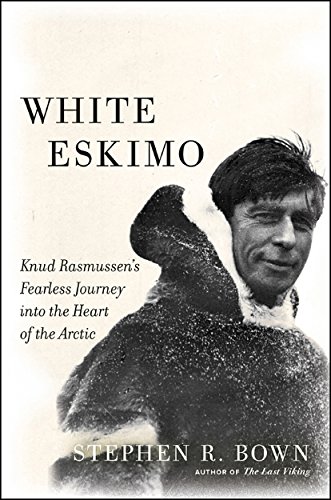
White Eskimo
Knud Rasmussen's Fearless Journey into the Heart of the Arctic
کتاب های مرتبط
- اطلاعات
- نقد و بررسی
- دیدگاه کاربران
نقد و بررسی

July 1, 2015
Canadian author Bown (The Last Viking: The Life of Roald Amundsen, 2012, etc.) fashions a thorough, insightful biography of the fearless explorer and noted writer Knud Rasmussen (1879-1933). Rasmussen translated his love of his native Greenland into painstaking chronicles of the Inuit culture gleaned over three decades of arduous, groundbreaking exploration. His extraordinary upbringing played a significant role in his remarkable ability to infiltrate the Inuit tribes and become a trusted scribe among them. The son of a Danish missionary who made "herculean dogsled expeditions to the farthest regions of his sprawling parsonage," Rasmussen learned early on the local Greenlandic language (his mother's heritage) and a love of hunting and bobsled culture. After being sent to school in Copenhagen and deciding he was not going to be an actor, he hit on journalistic writing as a profession. He made an initial inspirational trip to Lapland to chronicle the culture of the Sami people, developing the themes that would obsess him the rest of his life-namely, the vanishing of the traditional old ways "to the juggernaut of modernity," where "tradition and myth were replaced with the soullessness of the market economy." Beginning with the Danish Literary Expedition across northern Greenland (1903-1904), which yielded the wildly popular work People of the Polar North, Rasmussen and his trusty companion Peter Freuchen would embark over the next decades on numerous Thule Expeditions, taking them far into the recesses of Inuit tribes and producing extensive and significant records of vanishing worlds. Bown emphasizes the sheer vitality and charisma of Rasmussen, who shared his celebrity spotlight with the Inuit hunters, dog-sled drivers, and others who were key to the success of the expeditions. A vivacious study that will surely revive interest in the writings of this towering explorer and ethnographer.
COPYRIGHT(2015) Kirkus Reviews, ALL RIGHTS RESERVED.

September 15, 2015
Knud Rasmussen (1879-1933) is relatively unknown outside of Denmark and the world of Inuit studies. Bown (The Last Viking) seeks to change this with a thorough and engaging biography. Born in Greenland to Danish and part-Inuit parents, Rasmussen spent his early years learning the outdoor skills that would make him a successful explorer. His outgoing and curious nature enabled him to easily engage in both Danish and Greenlandic cultures. In 1910, Rasmussen and Peter Freuchen started a trading post called Thule Station in northwest Greenland. From there, they traveled far and wide around Greenland, including one expedition in which they crossed its ice cap in both directions. The fifth Thule Expedition (1921-24) was Rasmussen's most important; on it he traveled by dog sled through the Arctic seeking cultural similarities and even differences with the Greenlandic Inuit. He documented natives' legends, oral traditions, poetry, and songs, creating important ethnographic works that preserved traditions for future scholars. Bown makes excellent use of Rasmussen's expedition publications which were best sellers owing to his poetic and energetic style. VERDICT Readers of Arctic cultures and exploration should clamor for this joyous celebration of Rasmussen's life.--Margaret Atwater-Singer, Univ. of Evansville Lib., IN
Copyright 2015 Library Journal, LLC Used with permission.

September 15, 2015
Bown (The Last Viking, 2012) is on familiar ground as he shares the epic life of Knud Rasmussen, one of the twentieth century's greatest explorers. The chronology unfolds from his birth in Greenland to a Danish missionary father and a part-Inuit mother to turbulent boarding-school years and the development of his legendary career. Unlike his contemporaries, Rasmussen was interested less in being the first to get somewhere far away than in learning about the people who lived there. His journeys into the northern reaches of Greenland, and the books he wrote about them, such as The People of the Polar North (1908), changed the way exploration was viewed. Rasmussen was an explorer people could relate to, and he went out of his way to make the Inuit less the other. His lifelong effort to share those lives with the world was an enormous boost to the field of ethnography, and his unfailing respect for those he wrote about was a sharp departure from most other Arctic travelers. Bown has done an excellent job of bringing Rasmussen to lifeanother first-rate entry from this accomplished writer.(Reprinted with permission of Booklist, copyright 2015, American Library Association.)

























دیدگاه کاربران